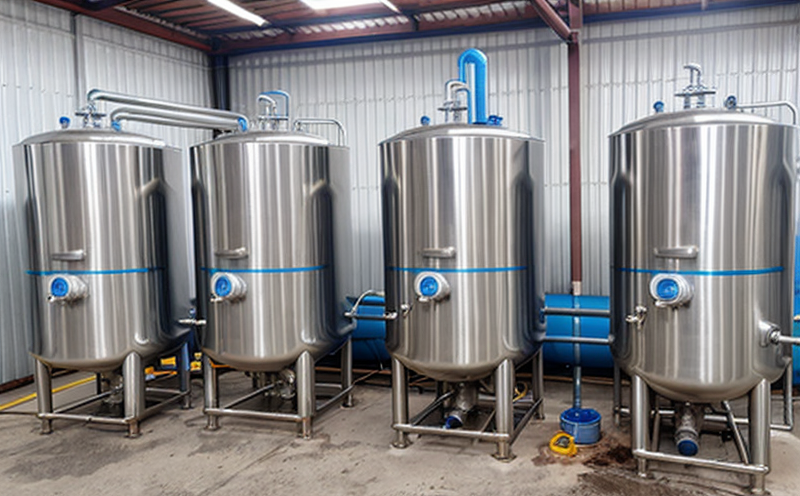ASTM D8221 Legionella Detection Test in Cooling Water
The ASTM D8221 Legionella detection test is a critical tool used by facilities to ensure the safety of their cooling water systems, particularly in environments where there is potential for legionellosis transmission. Legionella pneumophila bacteria can thrive in warm-water systems such as those found in cooling towers and evaporative condensers. This test helps identify the presence of these harmful organisms before they pose a threat to human health.
The importance of this test cannot be overstated, especially for facilities like hotels, hospitals, office buildings, and other large-scale structures where the health and safety of occupants are paramount. By implementing routine testing based on ASTM D8221, organizations can maintain compliance with regulatory requirements and safeguard their public image.
Legionella pneumophila is a gram-negative bacterium that causes Legionnaires' disease, a severe form of pneumonia. It is commonly found in environments where water is used or distributed at temperatures between 20°C and 45°C (68°F to 113°F). In cooling towers, this temperature range is often achieved when the water is sprayed into the atmosphere, creating an ideal environment for bacterial growth.
The ASTM D8221 test protocol involves several steps that are designed to ensure accurate detection of Legionella. These include:
- Water sampling from the cooling tower or evaporative condenser
- Culturing samples in appropriate media known as buffered charcoal yeast extract (BCYE) agar
- Incubation under specific conditions to allow for bacterial growth
- Identification of colonies that appear similar to Legionella using biochemical tests
The test is particularly important because it allows facilities to take proactive measures in addressing potential outbreaks. Early detection can lead to timely corrective actions, such as adjusting water treatment programs or improving system design.
| Applied Standards | Description |
|---|---|
| ASTM D8221-19 | Standard Test Method for Detection of Legionella spp. in Cooling Water by Culture. |
| ISO 11731:2015 | Microbiology of the Built Environment - Bacterial Pathogens - Sampling and Testing Methods. |
The ASTM D8221 protocol is widely recognized for its reliability in detecting Legionella spp., but it is important to note that no single test can guarantee complete elimination of risk. Facilities should consider this test as part of a comprehensive water management strategy that includes other control measures such as proper chemical treatment and regular cleaning.
Why It Matters
The health risks associated with Legionella infection are significant, making the ASTM D8221 test an essential component of any facility's water management program. The consequences of a legionellosis outbreak can be severe and include hospitalization, prolonged illness, and even death in vulnerable populations such as the elderly or individuals with weakened immune systems.
Legionnaires' disease is not only a public health concern but also an operational one. Outbreaks can lead to costly disruptions, including extended closures of facilities, increased cleaning and disinfection efforts, and potential legal liabilities. By implementing routine testing based on ASTM D8221, organizations can mitigate these risks and demonstrate their commitment to safety.
Furthermore, compliance with regulatory requirements such as the U.S. Occupational Safety and Health Administration (OSHA) standards is crucial for avoiding fines and penalties. The Centers for Disease Control and Prevention (CDC) also recommends regular monitoring of cooling water systems to prevent Legionella outbreaks.
In summary, the ASTM D8221 test is not just a technical procedure; it represents a critical step in maintaining public health and operational integrity. By incorporating this test into their routine maintenance practices, facilities can help ensure the safety of their occupants and protect against the financial and reputational impacts of an outbreak.
Applied Standards
| Standard | Description |
|---|---|
| ASTM D8221-19 Standard Test Method for Detection of Legionella spp. in Cooling Water by Culture | The ASTM D8221 protocol provides a standardized approach to detecting Legionella spp. through culturing and subsequent identification. |
| ISO 11731:2015 Microbiology of the Built Environment - Bacterial Pathogens - Sampling and Testing Methods | This international standard covers sampling techniques and testing methods for microbial pathogens in built environments, including water systems. |
Both standards are designed to ensure that Legionella detection is conducted accurately and consistently across different facilities. Compliance with these standards helps organizations achieve reliable results and demonstrate their commitment to safety and quality.
Use Cases and Application Examples
- Hospital environments where patients are particularly vulnerable to infection
- Office buildings that house large numbers of employees in close proximity
- Hotels with extensive cooling systems serving multiple guest rooms
- Manufacturing plants using significant amounts of water for industrial processes
| Use Case | Description |
|---|---|
| Hospital Cooling Systems | In hospitals, Legionella can pose a serious risk to patients. Regular testing helps ensure that cooling systems are safe for use. |
| Office Building Condensers | Office buildings with large condensing units can benefit from routine Legionella testing to prevent outbreaks among staff. |
| Hotel Cooling Towers | Hotels frequently have extensive cooling towers. Regular monitoring helps maintain guest safety and protects the facility's reputation. |
| Manufacturing Plants | Industries with heavy water usage require regular testing to ensure compliance with health and safety regulations. |
In each of these scenarios, the ASTM D8221 test plays a crucial role in identifying Legionella spp. early, allowing for timely intervention and prevention of potential outbreaks.





